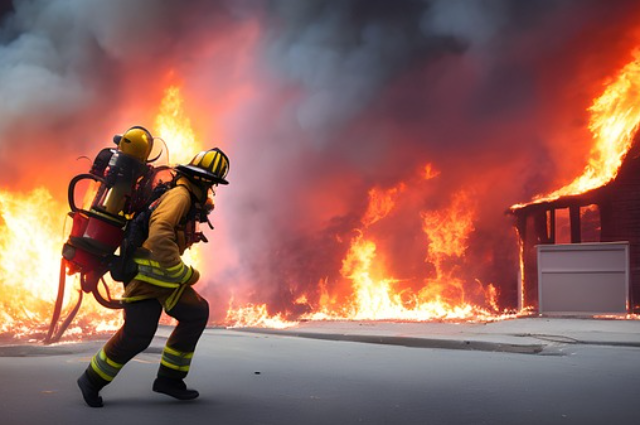
Image by TheTastefulMind from Pixabay
Introduction
Los Angeles, home to Hollywood, faces recurrent wildfires that threaten lives, property, and the entertainment industry. While the city attracts global attention for its celebrities and film industry, its location makes it vulnerable to devastating wildfires. This article examines the causes of LA wildfires, their impact on Hollywood, and the broader implications for urban development and climate change adaptation.
Why Los Angeles Faces Frequent Wildfires
Wildfires in LA are driven by natural and human factors. The region’s Mediterranean climate, with hot, dry summers and occasional strong winds, creates ideal conditions for fires. The Santa Ana winds, which occur in autumn, intensify wildfires by spreading flames rapidly over vast areas. Additionally, prolonged droughts—exacerbated by climate change—leave vegetation dry and highly flammable.
Urban expansion into fire-prone areas worsens the risk. As Los Angeles grows, more homes are built along the wildland-urban interface, where natural landscapes meet human settlements. This expansion increases fire ignition points and makes firefighting more complex.
Impact on Hollywood’s Infrastructure
Hollywood, as the epicentre of the entertainment industry, suffers significant disruptions from wildfires. Film studios, outdoor shooting locations, and celebrity homes are all at risk. In 2017, the Skirball Fire forced the closure of the Getty Center and shut down major roads, affecting production and daily business. The Woolsey Fire of 2018 burned parts of Malibu, where many actors and industry professionals reside.
Studios often have contingency plans, but wildfires delay productions, increase costs, and sometimes destroy sets. Insurance premiums for film productions have risen due to wildfire risks, adding financial pressure on the industry.
Effect on Celebrities and the Entertainment Industry
Many celebrities own homes in wildfire-prone areas such as Malibu, Calabasas, and Beverly Hills. Stars like Gerard Butler, Miley Cyrus, and Robin Thicke have lost homes to wildfires. The emotional and financial toll on celebrities highlights a broader issue: no one is immune to natural disasters, regardless of status or wealth.
Beyond personal losses, wildfires affect film projects. Outdoor shooting schedules are disrupted, locations become inaccessible, and smoky air quality forces production delays. Studios have relocated shoots or halted projects due to poor air conditions, affecting both local economies and global entertainment schedules.
Economic Consequences of Wildfires on Hollywood
The economic impact of wildfires extends beyond property damage. The entertainment industry contributes billions to California’s economy, and disruptions from wildfires affect revenue, employment, and tourism.
Insurance claims for fire damage cost billions, driving up premiums for studios and homeowners alike. The Woolsey Fire alone caused over $6 billion in damages. Additionally, tourism—vital to LA’s economy—declines during wildfire seasons as visitors avoid smoky conditions and road closures.
Climate Change and the Future of Wildfires in LA
Climate change increases the frequency and intensity of wildfires. Rising temperatures, prolonged droughts, and changing precipitation patterns create conditions for larger, more destructive fires. Experts predict that wildfire seasons will extend, making fire preparedness more crucial than ever.
The California government has introduced fire mitigation measures, including controlled burns, improved emergency response systems, and stricter building codes for fire-prone areas. However, as wildfires become more severe, Hollywood must adapt by reassessing its filming locations, investing in fire-resistant infrastructure, and supporting broader climate policies.
Steps Hollywood and LA Can Take
- To mitigate wildfire risks, both individuals and the industry must take action.
- Fire-Resistant Construction: Homeowners and studios should use fire-resistant materials and design properties to minimise fire spread.
- Emergency Preparedness: Regular fire drills, evacuation plans, and emergency kits can save lives and assets.
- Sustainable Land Management: Controlled burns, vegetation management, and firebreaks can reduce fuel for wildfires.
- Policy Advocacy: Hollywood, with its global influence, can support policies that address climate change and fire prevention.
- Alternative Filming Locations: Studios can plan shoots in safer regions during high-risk seasons to avoid disruptions.
Conclusion
Wildfires pose a persistent threat to Los Angeles, particularly to Hollywood and its entertainment industry. While climate and geography make fires inevitable, urban planning, better infrastructure, and proactive policies can reduce damage. The industry must adapt to this growing challenge by prioritising safety, sustainability, and resilience. As wildfires become more frequent, the response of Hollywood and LA will determine the future of both the city and its iconic industry.
